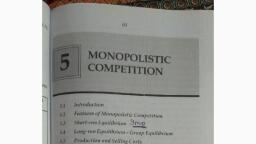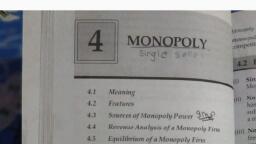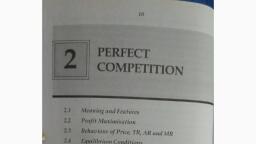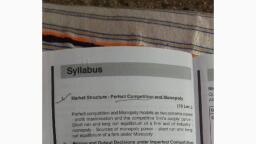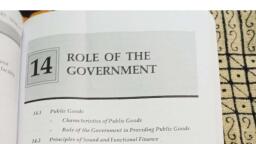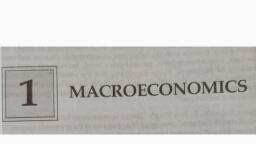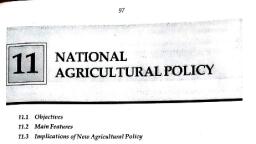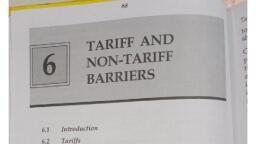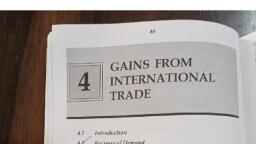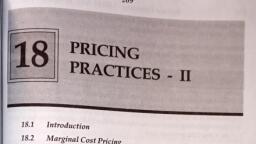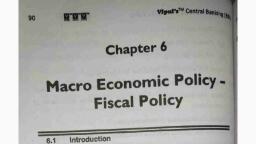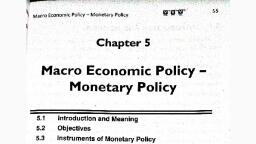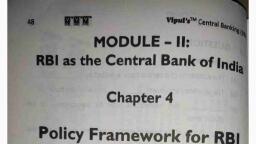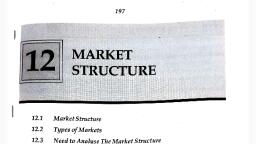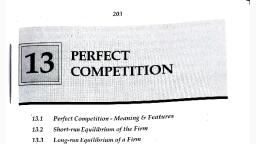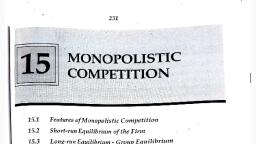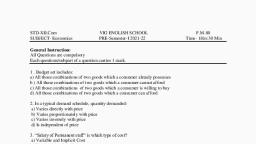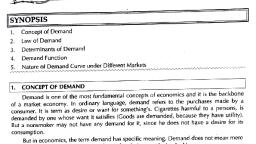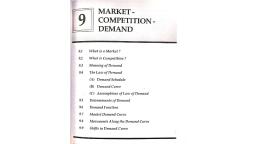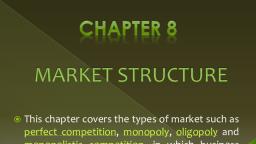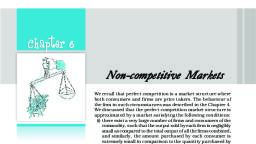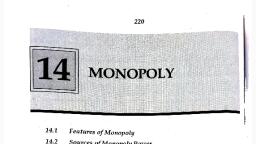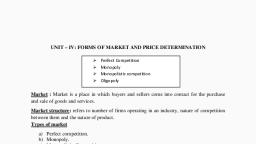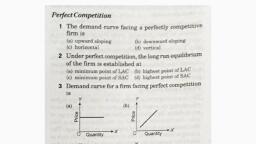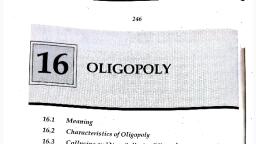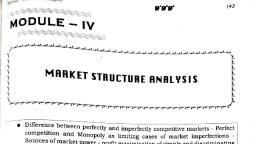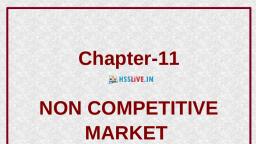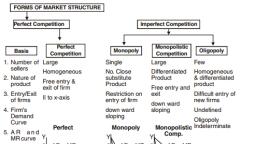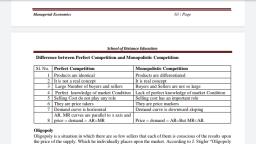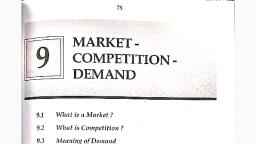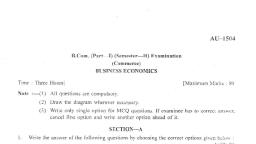Page 1 :
197, , MARKET, STRUCTURE, , , , , , , , , , , , , 12.1 Market Structure, 12.2 Types of Markets, 12.3. Need to Analyse The Market Structure, , CO aa, , , , Market is usually understood as a place where sellers (producers) and’, buyers meet for settling a transaction. A market is also defined "as a group, of firms and individuals that are in touch with each other in order to buy, or sell some good." In today's situation with the progress in the, communication system, it is not necessary to have a physical or personal, contact in a physical or geographical market area. Transactions take place, through electronic commerce, mobile commerce or with the help of other, communication media. What is essential is to have a communication, , between the buyer and seller for settling a transaction., , Depending on the commodity and supporting factors a market can be local,, national or international. For company stocks / shares the markets have, become national and in certain cases they are internationally traded., , Currency market is an example of international market., , A given type of market within the market structure depends on many factors, , such as (i) nature of commodity, (ii) freedom of entry and exit, (iii) control, over supply, (iv) control over price, etc. Based on the above and other factors, there are different types of markets which together form the market, , structure in the economy.
Page 2 :
198, , , , A market structure, market belongs de, , of seller. ; ., S and buyers, the nature and characteristics of a commodity, the, , influence exercise, and effects of adv, , Business Economics - I (BMS, BAF, BFM, BBI.: SEM-1) hw, , comprises different forms of markets. To which typea, Pends on a number of factors. They include the number, , d by the sellers or buyers in the market, the role, neeq, ertisement or selling cost and a host of other factors., , ae section we are dealing with commodity markets, that is, where goods, , services are bought and sold. In economic analysis, commodity markets, , @ Y cee classified into four categories, that is (1) Perfect Competition,, ee ae) Oligopoly and (4) Monopolistic Competition., , iL, , Perfect Competition is a market situation where we have a large, number of sellers and buyers. The commodity sold is identical with, , no quantitative and qualitative differences. The large number of buyers, and sellers naturally prevent a single seller or buyer from influencing } 3, the price. In a perfect competition a seller is a price taker. He accepts ¥~", the price determined in the market by the total demand and supply., Commodity being identical there is no scope for any price differential, and discrimination. Both sellers and buyers have complete information, , of market which helps establish uniform price., , There is no restriction for any person to produce and sell the existing, commodity. So also whoever wants to exit from the market is free to, , _do so., , Factors of production are perfectly mobile geographically and, occupationally. There is no transport cost., , Market for agricultural commodities is cited as near example for, perfect competition. Stock market is another example for this type of, , market., (For detail explanation refer Topic 13.1), , Monopoly market is different from perfect competition. Here we have, one producer (seller) selling the homogeneous or an unique product., The producer has almost near total control on the supply hence he, can decide the price and output. However in order to maximise the, , profit he would control either price or output. Being a sole supplier, he could discriminate the price between buyers as well as between, , markets., Like perfect competition it is difficult to have a real situation of, monopoly market where a producer has a total control over the supply.
Page 3 :
199, urket Structure |, ‘ ‘li vices, The nearest example that we can have are the public ees a naew, which are usually controlled by the government. At pe cn pplier., the case of water supply in Mumbai where BMC is the sole, , . ‘ t., Railway services are the monopoly of the Central Governmen, , It is expected that the government would not exploit, since it has a responsibility to promote the welfare of, Wherever such a monopoly is allowed in the private, government acts as a regulator., , t nil. If the entry is, , Entry to the market is highly restricted or almos, nopoly., , allowed then the market would not remain as a mo, ative devise in order, , A tisi i, dvertising may be resorted to only as a inform: y ceofulness: of the, , to make consumers aware of the existence an, product., , (For detail explanation refer Topic 14.1), , ardised or differentiated, es, automobile, t, medical drugs,, , Oligopoly market has few sellers selling stand, commodities. The common examples are airlin, manufacturers, computer manufacturers, steel, cemen', chemicals, petroleum, broadcasting / telecasting., , eality it is very-difficult, , finance etc. Being small, together and, , Entry to oligopoly market is free, however in r, as there are many barriers such as technology,, in number there is a possibility of these firms joining ;, forming a cartel, as is the case of organisation of petroleum exporting, countries (OPEC). Oligopoly firms may have an implicit, understanding whereby they influence price, as alleged in case of, domestic airlines., , Each firm may have some influence over the price specially when the, product is differentiated. Price of a oligopoly product can be decided, by a dominant firm which becomes a leader., , Advertising is also resorted since oligopoly firms compete with each, other. They also indulge in non-price competition to attract customers., , If the number is small, there is always a tendency. for the firms to, come together and form a cartel for the purpose of increasing price, and profits., , There is also a possibility of the oligopoly marketing turning into, monopoly through mergers and acquisition., , , , (For detail explanation refer Topic 16.1 and 16.2), 4
Page 4 :
200, , Business Economics - I (BMS, BAF, BFM, BBL.: SEM., , wnnoPolistic competition is a market situation where there are, , are ee differentiated products. Garments, soaps and detergen,, , trad ¢ examples. Monopolistic competition is clearly visible in ret, © where sellers sell differentiated products., , E ney to the market is not difficult though not as free as pertey, ompetition. Since a product is differentiated, restricting the enty}, , , , , , , , , , , , , , , , , , , , , , , , , , , , through patent right is difficult. és, pray differentiation is done through different design, size, coloy Fa, and other characteristics associated with the product. However, products remain close substitute to each other. 4, Selling cost is the essential aspect of monopolistic competition. Eagjp a, producer tries to convince the consumer that his product is betty fi, than that of his competitors. Advertisements through different medi a, 1s resorted to engage in non-price competition. In, Demand for the product of a monopolistic competitive firm is elast d?, since the products are close substitutes. n, Though price is determined by the market forces yet there is enoughs se, scope for price differentiation based on product differentiation. Fai) ax, firm may claim its product is superior to its substitute in terms df) ac, quality attributes. } at, (For detailed explanation refer Topic 15.1) D, : ol, Table 12.1 : Market Structure and Characteristics <<, 2 4, 7 at, Market Examples | No. of Nature Power to| Barriers} Non price», Structure Produ- of influence to Competitia, WR., cers Product Price Entry br, Perfect Some Large | Standardised | None Nil | None r, Competition | agricultural (identical) e, commodities}, Monopoly Public One _ | Unique Consi- Very | Advertising, utilities Product derable | High, Oligopoly Computers,| Few | Standardised | Some High Advertising), Crude oil, or and Produc, Steel, Differentiated differentia)», Airlines ., Monopolistic | Garments Many | Differentiated] Some Low ners), Competition | (retail trade) and Prodv, differentia!®, _—"
Page 5 :
Market Structure 201, , , , ch, ter, , stig, , ——, ce, ion, , , , | For an entrepreneur, it is absolutely necessary to understand the market, environment in which he would be operating. It would help him understand, his strength and weakness as a producer and seller., , | Nature of demand: The nature of demand curve for a finished product, depends on the type of market in which a firm operates. Based on the, demand the firm requires to take the decision about the quantity it produces, and price at which it can sell its product., , Price decision: If the firm is going to operate in a perfectly competitive, markets, he is a price taker unlike ina monopoly where he is a price maker., Inother markets he has a certain degree of influence on price due to product, differentiation or other factors., , Incurring Selling cost: Ina perfect competition it is not necessary to incur, selling cost. In oligopoly and monopolistic competition a firm must spend, and outdo its competitors. In monopoly there is scope for informative, | advertising. Understanding the market enables a firm to decide the nature, and extent of selling cost., , Degree of competition: If a firm -has to operate in monopolistic or, oligopolistic market, it has to be prepared to face a fierce competition. A, complete understanding of the market in which the firm is entering is absolutely necessary., , For an entrepreneur it is of utmost importance, before he ventures into a, business to study and understand the various aspects of a given type of, market. Knowing the market, in respect of advantages and hurdles is, essential before one embarks upon.a business. ., , , , Jk, What is a market ? Explain fully the term 'market structure’., , 2. Discuss the characteristics of different types of markets that constitute, the market structure., , 3. Write short notes on:, (a) Market Structure, , , , (b) Need to study the market structure.
